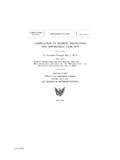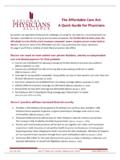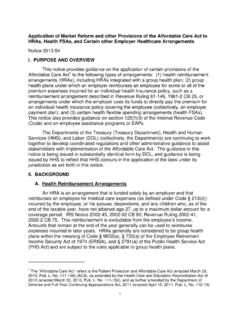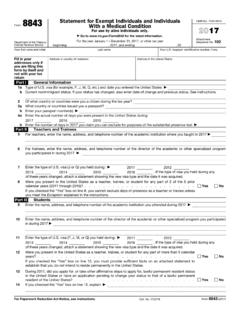Transcription of Patient Protection and Affordable Care Act (PPACA) 2018 ...
1 Patient Protection and Affordable care Act (PPACA)2018 financial impact analysis for EmployersSample 1#Table of ContentsActuarial Provisions of and Plan Specific Excise Tax - 8 Actuarial 1 Actuarial CertificationThis report contains the results of an analysis to estimate the "Cadillac" excise tax impact in 2018. Enrollment projectionsassess eligibility for Medicaid and Federal Subsidies, as well as costs related to in- and out-migration due to individual mandates,and auto enrollment or movement to State Health Exchanges. The calculations are based on data input by the user of the PPACA calc actuarial model, including current employer specific censusdata and plan enrollment, key cost-sharing provisions of current plan options, and health care cost related information.
2 As such,Verisight has not reviewed the data, and cannot attest to the accuracy of the user information input. Similarly, assumptionsutilized in the model include a number of user selected variable inputs, beyond those encoded assumptions Verisight healthactuaries have selected from our knowledge and expertise. The propriety of specific assumptions relates to theircomparability to historical experience levels and reasonable future behaviors and trends in employee demographics, health carecosts, and utilization and delivery of services. Results from this product can be extremely sensitive to the assumptionschosen. While we may not be able to attest to the user input assumptions, we do confirm that the model developed and theassumptions encoded are reasonable and consistent with our understanding of the current provisions of PPACA, and our relevantexperience working in the employee health benefits and insurance fields.
3 The results are estimates, based on current data, assumptions, and PPACA provisions. Because many of the assumptions andprovisions are subject to external influences (demographic, economic, and regulatory) beyond our control or that of a PPACA calcuser, actual results may vary materially. Determinations for purposes other than estimating potential plan enrollment andemployer plan sponsor costs in 2018 under current PPACA provisions may also be significantly different from the results Verisight health actuaries that developed PPACA calc have done so using generally accepted accounting principles, includingthe Actuarial Standards Board Actuarial Standards of Practice (ASOPs) relating to health benefits.
4 We have satisfied the basiceducation, experience, and continuing education requirements and are qualified to issue Statements of Actuarial Opinion inaccordance with the Qualification Standards in the American Academy of Actuaries' Code of Professional Conduct. However,since this product was specifically developed as an online, easy-to-use, do-it-yourself product for health insurance brokers andconsultants to use for clients, as well as for employer plan sponsors to use directly themselves, the results generated won't beconsidered an actuarial statement of is independent and unbiased, and has no political agenda for users of this product, or any of its officers or keypersonnel, that would impair our objectivity in the ongoing development and consulting activities related to PPACA calcmodeling.
5 We are available to answer any questions on the material contained in the report, or to provide explanations orfurther details as may be , 2 Key Provisions of PPACA2018 Excise Tax Provisions PPACA imposes a 40% excise tax on group health plans (including self insured plans) whose costs exceed certain thresholds for plan years beginning on or after 1/1/2018. Tax-advantaged health-related accounts such as flexible spending accounts (FSAs), health savings accounts (HSAs), and health reimbursement accounts (HRAs) are also specified as health insurance coverage and included in the excise tax calculation. Non-union threshold amounts in 2018 are $10,200 for single coverage and $27,500 for non-single coverage.
6 These amounts will be indexed by growth in the CPI-U plus 1% in subsequent years. Different amounts apply to multi-employer plans. PPACA calc does not currently model the 2018 excise tax exposure for multi-employer (union) plans. The cost includes employer and employee paid portions (based on a methodology similar to that used under COBRA). The tax is paid by the insurance company (if the plan is insured) or plan administrator (if the plan is self insured). Since the employer is typically the plan administrator for tax-advantaged accounts (FSAs, etc), the employer would have a liability for part of the excise tax even in the case where the health plan is fully insured.
7 employers are responsible for determining the amount of the excise tax and the allocation between the employer and insurer. employers must report these amounts to the Internal Revenue Service. The amount of the excise tax is not deductible from federal income 3 Executive SummarySample 1#Projected 2018 Excise TaxesPlan DesignSingleFamilyPlan 1$0$0 Plan 2$133,336$75,710 Plan 3$10,142$0 Plan Projected 2018 Excise Taxes$143,478$75,710 Page 4 Demographic and Plan DataSample 1#2012 Enrollment DataEEEE & SpouseEE & ChildEE & FamilyTotalPlan 1620221784 Plan 2730121196 Plan 3600281199 Plan 43405544 Total Employees229067443402014 Projected EnrollmentEEEE & SpouseEE & ChildEE & FamilyTotalPlan 18102922132 Plan 29501614125 Plan 37803614128 Plan 44407758 Total Employees298088574432012 Premium/Funding RatesEEEE & SpouseEE & ChildEE & FamilyTotalPlan 1$ $ $ $1, $ 2$ $ $1, $1, $ 3$ $ $ $1, $ 4$ $ $ $1, $ 5 PPACA Excise Tax analysis - Plan 1 Sample 1#SingleFamilyProjected 2018 Premium - Per Employee$7,980$19,654 Projected Excise Tax Threshold$10,200$27.
8 500 Amount Subject to Taxation$0$040% Excise Tax 2018 Per Employee Tax$0$0 Projected 2018 Tax$0$0 Total 2018 Tax$0 Health Carrier Allocation1 $0$0 Plan Administrator Allocation1 $0$01 For self insured plans, the employer will have 100% of the excise tax liability. Page 6 PPACA Excise Tax analysis - Plan 2 Sample 1#SingleFamilyProjected 2018 Premium - Per Employee$13,709$33,809 Projected Excise Tax Threshold$10,200$27,500 Amount Subject to Taxation$3,509$6,30940% Excise Tax 2018 Per Employee Tax$1,404$2,524 Projected 2018 Tax$133,336$75,710 Total 2018 Tax$209,045 Health Carrier Allocation1 $119,545$69,360 Plan Administrator Allocation1 $13,790$6,3501 For self insured plans, the employer will have 100% of the excise tax liability.
9 Page 7 PPACA Excise Tax analysis - Plan 3 Sample 1#SingleFamilyProjected 2018 Premium - Per Employee$10,525$24,256 Projected Excise Tax Threshold$10,200$27,500 Amount Subject to Taxation$325$040% Excise Tax 2018 Per Employee Tax$130$0 Projected 2018 Tax$10,142$0 Total 2018 Tax$10,142 Health Carrier Allocation1 $8,776$0 Plan Administrator Allocation1 $1,366$01 For self insured plans, the employer will have 100% of the excise tax liability. Page 8 PPACA Excise Tax analysis - Plan 4 Sample 1#SingleFamilyProjected 2018 Premium - Per Employee$7,748$18,441 Projected Excise Tax Threshold$10,200$27,500 Amount Subject to Taxation$0$040% Excise Tax 2018 Per Employee Tax$0$0 Projected 2018 Tax$0$0 Total 2018 Tax$0 Health Carrier Allocation1 $0$0 Plan Administrator Allocation1 $0$01 For self insured plans, the employer will have 100% of the excise tax liability.
10 Page 9 Actuarial AssumptionsSample 1#Medical TrendRateFederal Poverty Level (By Family Size)Marginal Tax Rates2012 $10,890$14,710$18,530$22, $11,065$14,947$18,828$22,7102015 $11,243$15,187$19,131$23,075 Household Income 2016 $11,425$15,432$19,439$23,4472014 Factor1 Family Size (By Rating Tier)Wage TrendRate2019 Tier3 Tier4 Tier2012 Plus SpouseN/A222014 Plus ChildN/AN/A22023 The household income factor represents the ratio of household income to the employee's 2014 projected salary. It was assumed that 50% of eligible employees who are currently waiving, have household income of less than or equal to 400% of the federal poverty level, and have an employee contribution that is less than of their household income will elect to join the employer's benefit planin 2014 once the individual mandate is effective.





